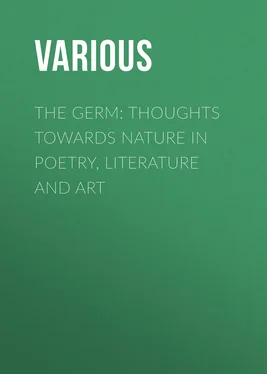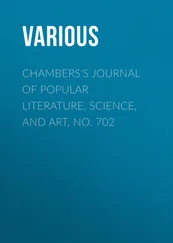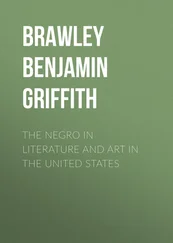Various - The Germ - Thoughts towards Nature in Poetry, Literature and Art
Здесь есть возможность читать онлайн «Various - The Germ - Thoughts towards Nature in Poetry, Literature and Art» — ознакомительный отрывок электронной книги совершенно бесплатно, а после прочтения отрывка купить полную версию. В некоторых случаях можно слушать аудио, скачать через торрент в формате fb2 и присутствует краткое содержание. Жанр: foreign_prose, foreign_antique, на английском языке. Описание произведения, (предисловие) а так же отзывы посетителей доступны на портале библиотеки ЛибКат.
- Название:The Germ: Thoughts towards Nature in Poetry, Literature and Art
- Автор:
- Жанр:
- Год:неизвестен
- ISBN:нет данных
- Рейтинг книги:3 / 5. Голосов: 1
-
Избранное:Добавить в избранное
- Отзывы:
-
Ваша оценка:
- 60
- 1
- 2
- 3
- 4
- 5
The Germ: Thoughts towards Nature in Poetry, Literature and Art: краткое содержание, описание и аннотация
Предлагаем к чтению аннотацию, описание, краткое содержание или предисловие (зависит от того, что написал сам автор книги «The Germ: Thoughts towards Nature in Poetry, Literature and Art»). Если вы не нашли необходимую информацию о книге — напишите в комментариях, мы постараемся отыскать её.
The Germ: Thoughts towards Nature in Poetry, Literature and Art — читать онлайн ознакомительный отрывок
Ниже представлен текст книги, разбитый по страницам. Система сохранения места последней прочитанной страницы, позволяет с удобством читать онлайн бесплатно книгу «The Germ: Thoughts towards Nature in Poetry, Literature and Art», без необходимости каждый раз заново искать на чём Вы остановились. Поставьте закладку, и сможете в любой момент перейти на страницу, на которой закончили чтение.
Интервал:
Закладка:
Various
The Germ: Thoughts towards Nature in Poetry, Literature and Art
INTRODUCTION
Of late years it has been my fate or my whim to write a good deal about the early days of the Præraphaelite movement, the members of the Præraphaelite Brotherhood, and especially my brother Dante Gabriel Rossetti, and my sister Christina Georgina Rossetti. I am now invited to write something further on the subject, with immediate reference to the Præraphaelite magazine “The Germ,” republished in this volume. I know of no particular reason why I should not do this, for certain it is that few people living know, or ever knew, so much as I do about “The Germ,”; and if some press-critics who regarded previous writings of mine as superfluous or ill-judged should entertain a like opinion now, in equal or increased measure, I willingly leave them to say so, while I pursue my own course none the less.
“The Germ” is here my direct theme, not the Præraphaelite Brotherhood; but it seems requisite to say in the first instance something about the Brotherhood—its members, allies, and ideas—so as to exhibit a raison d'être for the magazine. In doing this I must necessarily repeat some things which I have set forth before, and which, from the writings of others as well as myself, are well enough known to many. I can vary my form of expression, but cannot introduce much novelty into my statements of fact.
In 1848 the British School of Painting was in anything but a vital or a lively condition. One very great and incomparable genius, Turner, belonged to it. He was old and past his executive prime. There were some other highly able men—Etty and David Scott, then both very near their death; Maclise, Dyce, Cope, Mulready, Linnell, Poole, William Henry Hunt, Landseer, Leslie, Watts, Cox, J.F. Lewis, and some others. There were also some distinctly clever men, such as Ward, Frith, and Egg. Paton, Gilbert, Ford Madox Brown, Mark Anthony, had given sufficient indication of their powers, but were all in an early stage. On the whole the school had sunk very far below what it had been in the days of Hogarth, Reynolds, Gainsborough, and Blake, and its ordinary average had come to be something for which commonplace is a laudatory term, and imbecility a not excessive one.
There were in the late summer of 1848, in the Schools of the Royal Academy or barely emergent from them, four young men to whom this condition of the art seemed offensive, contemptible, and even scandalous. Their names were William Holman-Hunt, John Everett Millais, and Dante Gabriel Rossetti, painters, and Thomas Woolner, sculptor. Their ages varied from twenty-two to nineteen—Woolner being the eldest, and Millais the youngest. Being little more than lads, these young men were naturally not very deep in either the theory or the practice of art: but they had open eyes and minds, and could discern that some things were good and other bad—that some things they liked, and others they hated. They hated the lack of ideas in art, and the lack of character; the silliness and vacuity which belong to the one, the flimsiness and make-believe which result from the other. They hated those forms of execution which are merely smooth and prettyish, and those which, pretending to mastery, are nothing better than slovenly and slapdash, or what the P.R.B.'s called “sloshy.” Still more did they hate the notion that each artist should not obey his own individual impulse, act upon his own perception and study of Nature, and scrutinize and work at his objective material with assiduity before he could attempt to display and interpret it; but that, instead of all this, he should try to be “like somebody else,” imitating some extant style and manner, and applying the cut-and-dry rules enunciated by A from the practice of B or C. They determined to do the exact contrary. The temper of these striplings, after some years of the current academic training, was the temper of rebels: they meant revolt, and produced revolution. It would be a mistake to suppose, because the called themselves Præraphaelites, that they seriously disliked the works produced by Raphael; but they disliked the works produced by Raphael's uninspired satellites, and were resolved to find out, by personal study and practice, what their own several faculties and adaptabilities might be, without being bound by rules and big-wiggeries founded upon the performance of Raphael or of any one. They were to have no master except their own powers of mind and hand, and their own first-hand study of Nature. Their minds were to furnish them with subjects for works of art, and with the general scheme of treatment; Nature was to be their one or their paramount storehouse of materials for objects to be represented; the study of her was to be deep, and the representation (at any rate in the earlier stages of self-discipline and work) in the highest degree exact; executive methods were to be learned partly from precept and example, but most essentially from practice and experiment. As their minds were very different in range and direction, their products also, from the first, differed greatly; and these soon ceased to have any link of resemblance.
The Præraphaelite Brothers entertained a deep respect and a sincere affection for the works of some of the artists who had preceded Raphael; and they thought that they should more or less be following the lead of those artists if they themselves were to develop their own individuality, disregarding school-rules. This was really the sum and substance of their “Præraphaelitism.” It may freely be allowed that, as they were very young, and fired by certain ideas impressive to their own spirits, they unduly ignored some other ideas and theories which have none the less a deal to say for themselves. They contemned some things and some practitioners of art not at all contemptible, and, in speech still more than in thought, they at times wilfully heaped up the scorn. You cannot have a youthful rebel with a faculty who is also a model head-boy in a school.
The P.R.B. was completed by the accession of three members to the four already mentioned. These were James Collinson, a domestic painter; Frederic George Stephens, an Academy-student of painting; and myself, a Government-clerk. These again, when the P.R.B. was formed towards September 1848, were all young, aged respectively about twenty-three, twenty-one, and nineteen.
This Præraphaelite Brotherhood was the independent creation of Holman-Hunt, Millais, Rossetti, and (in perhaps a somewhat minor degree) Woolner: it cannot be said that they were prompted or abetted by any one. Ruskin, whose name has been sometimes inaccurately mixed up in the matter, and who had as yet published only the first two volumes of “Modern Painters,” was wholly unknown to them personally, and in his writings was probably known only to Holman-Hunt. Ford Madox Brown had been an intimate of Rossetti since March 1848, and he sympathized, fully as much as any of these younger men, with some old-world developments of art preceding its ripeness or over-ripeness: but he had no inclination to join any organization for protest and reform, and he followed his own course—more influenced, for four or five years ensuing, by what the P.R.B.'s were doing than influencing them. Among the persons who were most intimate with the members of the Brotherhood towards the date of its formation, and onwards till the inception of “The Germ,” I may mention the following. For Holman-Hunt, the sculptor John Lucas Tupper, who had been a fellow Academy-student, and was now an anatomical designer at Guy's Hospital: he and his family were equally well acquainted with Mr. Stephens. For Millais, the painter Charles Allston Collins, son of the well-known painter of domestic life and coast-scenes William Collins; the painter Arthur Hughes; also his own brother, William Henry Millais, who had musical aptitudes and became a landscape-painter.
Читать дальшеИнтервал:
Закладка:
Похожие книги на «The Germ: Thoughts towards Nature in Poetry, Literature and Art»
Представляем Вашему вниманию похожие книги на «The Germ: Thoughts towards Nature in Poetry, Literature and Art» списком для выбора. Мы отобрали схожую по названию и смыслу литературу в надежде предоставить читателям больше вариантов отыскать новые, интересные, ещё непрочитанные произведения.
Обсуждение, отзывы о книге «The Germ: Thoughts towards Nature in Poetry, Literature and Art» и просто собственные мнения читателей. Оставьте ваши комментарии, напишите, что Вы думаете о произведении, его смысле или главных героях. Укажите что конкретно понравилось, а что нет, и почему Вы так считаете.












